Very many thanks to Caroline Hedengren-Dillon, who generously contributed her own research material on this topic, also to Huw Williams, librarian of the Oxford and Cambridge Club, London, who helped me to acquire other materials. Images from the Internet Archive can be used without prior permission for any scholarly or educational purpose as long as you (1) credit the source and (2) link your document to this URL in a web document or cite the Victorian Web in a print one. Click on all the pictures to enlarge them.]

Memorial at Cawnpore (present-day Kanpur), devised by Charlotte, Countess Canning (1817-61) and her sister Louisa Anne Beresford, Marchioness of Waterford (1818-91), with the figure of an angel executed by Baron Carlo Marochetti (1805-67) and a screen by Colonel Sir Henry Yule (1820-89) and C. B. Thornhill, Commissioner of Allahabad and superintending architect (see Keene 44, and "The Cawnpore Memorial"). Photographic print from a Photograph by Samuel Bourne, 1865. Courtesy of the British Library's Online Gallery.
For the British, the butchering of seventy-three women and 124 children at Cawnpore in July was the single most traumatic episode of the uprisings of 1857 (figures given in David 254). When the rebels were defeated and the atrocity discovered, it provoked a dreadful and indiscriminate revenge, and continued to reverberate in the British consciousness for many years to come. The sympathy that it aroused found expression in a monument, originally raised over the well itself, displaying an angel with lowered eyes. This was guarded” by a stone screen reminiscent of church architecture – and thus of Christian civilisation in general. In this way, the monument as a whole served as a rebuke and a justification of empire as well as a memorial.
It seems extraordinary at first sight that Baron Marochetti, with his European background, should have been approached to execute what is arguably "the most iconic of all British sculptural works in India, a site that during the last third of the Nineteenth Century was reportedly more often visited by Europeans in India than was the Taj Mahal" (Heathorn); a site that "every tourist sketched, and every traveller's book described" (Morris 192). How did it come about? And what exactly does the angel represent?
"Remember the Bibighar"

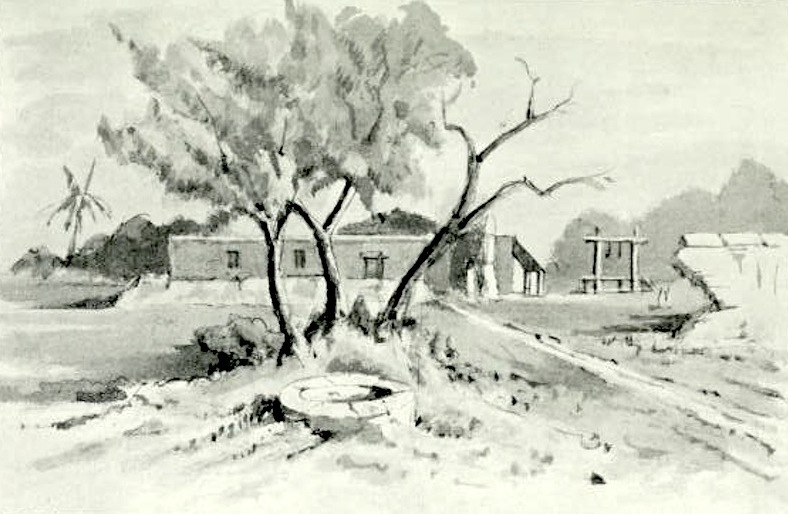
Left: The Bibighar. Source: Forrest, facing 476. Right: The Well, Cawnpore. Notice the gibbet to the right of the building, where hangings took place later. Source: Forrest, facing 478.
"Bibighar"(or "Bibighur") means the "House of Women," and it refers to a house originally built” by a British officer in Cawnpore for his Indian mistress. As Lady Canning, wife of the Governor General, explained in one of her "journal-letters," it consisted of "[t]wo little bungalows, with a small walled court between them" (qtd. in Hare II: 60). This is where rebel forces under the leadership of the local potentate Nana Sahib eventually brought the surviving women and children after a long siege which had culminated in a surrender and the massacre of their menfolk at Sati Chauri Ghat, or Massacre Ghat, on the Ganges riverside. The men's fate had been cruel enough, and some of their family members had already died in the siege. But before the town could be retaken, orders were given that those who had survived thus far, and had been taken captive, should be killed as well. When the sepoys themselves proved unwilling, one of Nana Sahib's personal bodyguards, two other men in his employ, and two butchers in their butcher's aprons, were dispatched to do the job instead (see David 253).
In the annals of empire, many if not all such incidents, or at least their motives and scale, are disputed, and much controversy surrounds this one too. However, the main facts are not in doubt. Even according to a recent Indian account, which is much less graphic and raw than the British ones of the time, "[t]heir bodies – it was said that not all were dead – were thrown into a well" (Mukherjee and Kapoor 122). The episode made an enormous impact, because it was the first time that women and children had suffered the brunt of native hostility, and it brought out the worst in the British too, provoking counter-atrocities here and elsewhere, particularly in Delhi. So long did it fester in the British consciousness that it contributed largely to the main theme of Paul Scott's Raj Quartet (1966-74) over a century later, and even today produces a steady stream of scholarly investigations and discussions.
Planning the Monument
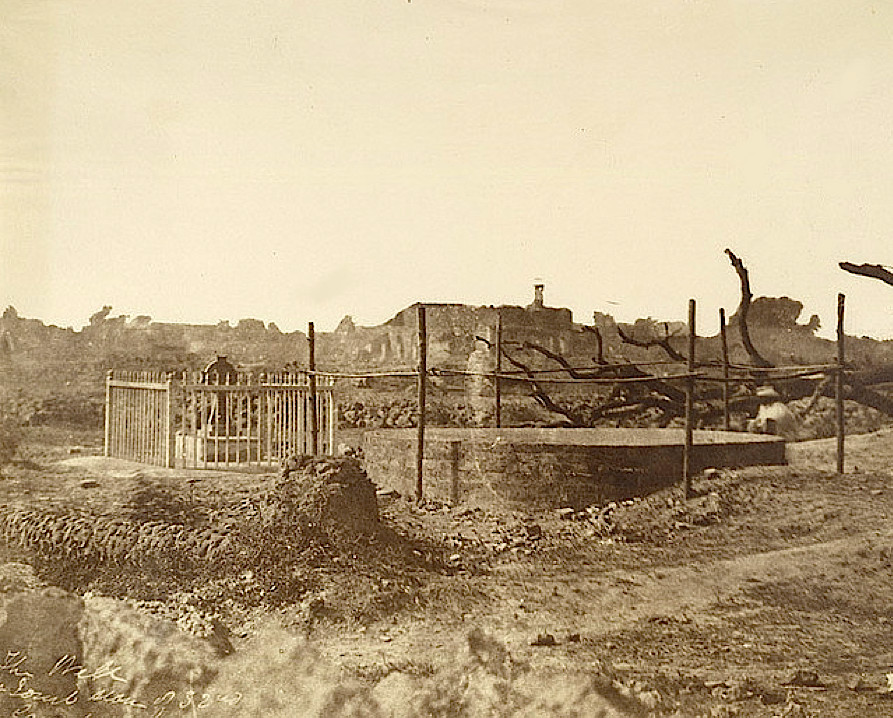
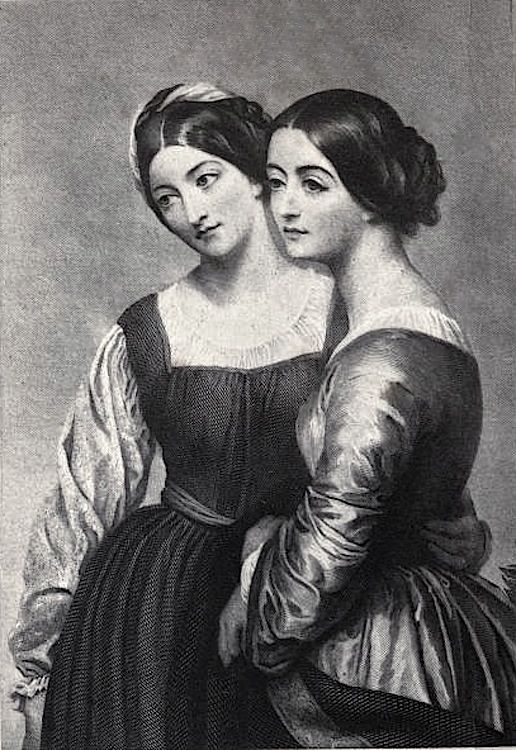
Left: The Well and Monument, Slaughter House [i.e., the Bibighar], Cawnpore, taken” by Dr John Murray in 1858. Courtesy of the British Library's Online Gallery. Right: Charlotte, Countess Canning, and her sister Louisa. Source: Hare I: frontispiece.
As for the mass grave, there was never any option but to leave the already badly decomposed remains in the dry well itself. It was first simply filled in with earth, and crudely fenced off. In due course a cross was erected nearby, as seen above left. It bore the text, "I believe in the resurrection of the body" (David 550), in contrast to the cross erected near the British entrenchment, which carried the more graphic though "singularly appropriate" text from Psalm 141: "Our bones are scattered at the grave's mouth as when one cutteth and cleaveth wood upon the earth, but our cryes are unto thee, O God the Lord" (qtd. in S.H.K. 362). Later, the well was covered with a brick top, and the ground around it completely cleared. But while the British forces vented their anger, to the growing dismay of Lord Canning and others – "I protest against meeting atrocities with atrocities," declaimed Disraeli (qtd. in Dalrymple 436) – two women planned a more substantial memorial for the defenceless victims of the uprising, who had met such brutal deaths.
The Governor General and his wife had only come out to India the year before the rebellion, and Lady Canning was greatly distressed by the tragedy, writing to Queen Victoria that of "all the horrors we have to mourn over.... The Cawnpore massacres were the worst of all" (qtd. in Surtees 235). Like her younger sister at home, Louisa, Countess of Waterford, she was artistically gifted. As a young girl, she had had "greater facility with landscapes and buildings" than Louisa, who, for her part, spent "every spare moment with original compositions of figures" (Hare I: 151). As early as the August of that fateful year, she wrote in another "journal-letter": “I want that well where they were all thrown down to be consecrated, with the ground around, and a plain monument put over them. C. [her husband] would do it – a chapelle expiatoire. I must think of a design, or – ask Lou [Louisa] quietly to make me one” (Hare II: 258). In the following year, Lady Canning "extensively discussed" plans for a fitting memorial for the victims of the Cawnpore with Colonel Yule (Henderson 17), a close friend of the Cannings, who happened to be visiting Roorkee in Uttarakhand in 1859. Roorkee was the headquarters of the Ganges Canal, and his former station (see MacLagan 110). It was not going to be such a "plain" affair after all.” by 1860, when the plans for it had been announced, the Bibighar had been demolished and the nearby well sealed with bricks (see Tickell 9).
However, Admiral Lord Charles Beresford, the two sisters' nephew, listed the design of the Cawnpore Memorial, without any qualifying remarks, as one of her Louisa's achievements: "The Marchioness was a lady of taste," he writes, "and was considered the most talented amateur painter of her day." Apart from her work on her own home and extensive gardens, he adds, she "designed the Cawnpore Memorial, designed Ford village, formerly the property of the Delavals in Northumberland, and achieved a series of cartoons representing religious subjects, which adorn the walls of the school at Ford" (xvii). This strongly suggests that Louisa had indeed sent out some sketches for the memorial, although there was obviously a rather large and complex collaborative process at work here, with both her sister and Yule involved in the architectural and landscaping elements; the Commissioner of the division, C. B. Thornhill, superintending the construction; and later a Mr G. E. Lance working on the surrounding gardens (see Keene 44).
The Sculptural Centrepiece

The angel framed in the entrance. On the scrolls on each side are the words, "These are they which came out / of great tribulation." Photograph by Lala Deen Dayal (1844–1905) after 1885, albumen silver print. Courtesy of the J. Paul Getty Museum, Los Angeles.
Having announced the project, Lord Canning needed to commission a sculptor for the sculptural centrepiece. There was an obvious choice. As young girls in a diplomatic family, Lady Canning and her sister had spent some of their childhood in Paris, where one of their playmates had been Camille de Maussion – the sculptor Baron Carlo Marochetti's future wife (see Hare I: 152). Moreover, before accompanying her husband to India, Lady Canning had been for thirteen years a "lady of the bedchamber" to Queen Victoria, and the two remained attached to each other, corresponding regularly. Queen Victoria was herself a great admirer of the Baron. These factors could not but have weighed in Marochetti's favour. In 1856, he had moreover completed a major memorial for another theatre of war, the Crimea. The Scutari monument, an obelisk with a complement of four mourning angels, had been unveiled in a ceremony full of pageantry.
Marochetti however demurred, perhaps recalling complaints of favouritism after his government commission for the earlier work. He wanted other sculptors to have a chance to compete for this new commission. Various proposals were in fact submitted. For example, one sculptural group by Thomas Woolner was swiftly rejected as being far too realistic a representation of what had actually happened: it showed an agonised and probably mortally wounded mother sinking down, with the body of a child at her feet. Only after this was Marochetti persuaded to modify his own ideas for the work, which at one stage had involved a figure of Britannia (see Llewellyn-Jones 185).
Once again, Lord Beresford credits his aunt Louisa, who excelled in figure drawing, with the final design (I: 168). The sisters' biographer Augustus Hare, on the other hand, credits Lady Canning herself with it. She perhaps had the text of the temporary memorial cross in mind: "When it was proposed to erect a memorial at Cawnpore, Lady Canning said, 'The hope of the Resurrection is the only thought which can calm sorrow or bring comfort in connection with the awful catastrophe which is connected with the place; therefore let a statue of the Angel of the Resurrection be placed over the well.'" Hare adds categorically, "The idea of the statue was hers," making Marochetti seem nothing but an inept meddler, who "unwisely altered it by placing two palm-branches instead of one in the arms of the angel" (3: 60).

One of the four Angels of Peace for Marochetti's Scutari Monument. Source: Illustrated London News. 17 May 1856: 525.
Both claims relegate Marochetti to the sideline. Did his role really consist in "unwisely" altering a preconceived design? As finally approved, his angel is, in fact, very like those on the Scutari monument. There have been modifications. The wings are noticeably less curved, enclosing the figure less; they look as if they might actually aid rather than impede flight. Moreover, this angel's head seems just a little inclined to the left. She carries no wreath, her arms are crossed over the breast rather than below it, and the robes flow in a more natural way, so that the figure as a whole seems less stylised. These are exactly the kind of changes that Louisa, with her penchant for flowing garments and her "strong eye for detail" might have suggested (Butler 161). But there are indeed two palm branches rather than one, and Marochetti's angel, unlike Louisa's, carries no censer. No doubt the sculptor had received and attended to suggestions and even sketches by the talented Lady Canning and her sister. Nevertheless, the general similarity to his earlier work is unmistakable and widely recognised. Most would agree that when all was said and done, "the patient sculptor finally came up with a version based on his Scutari Angel" (Llewellyn-Jones 185).
The Angel as a Symbol
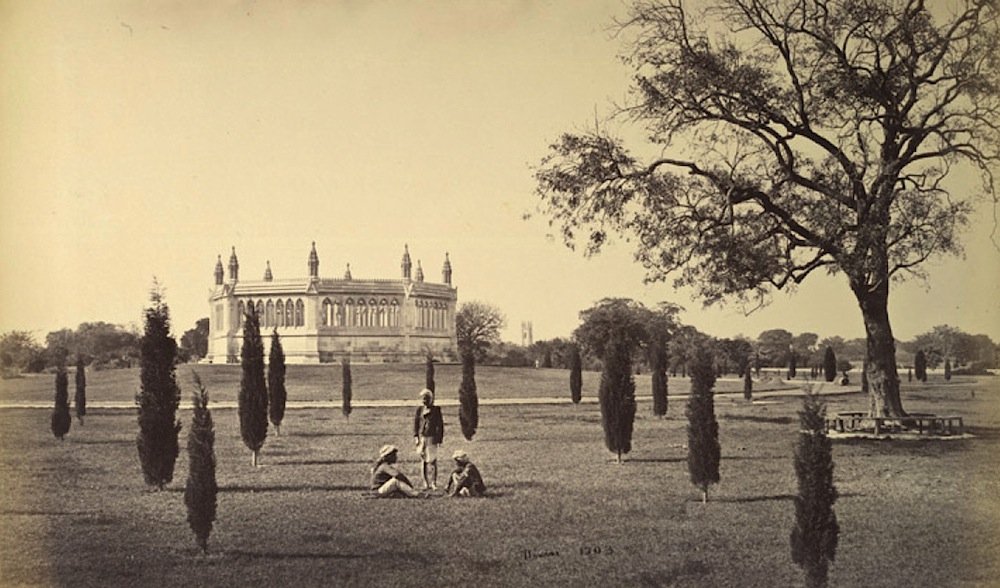
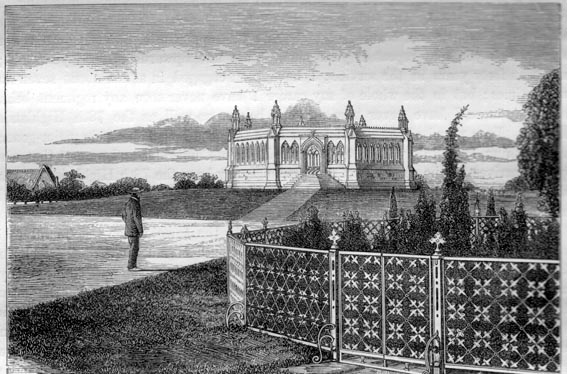
Two views of the Memorial Garden, Cawnpore. Left: Another photographic print from a Photograph by Samuel Bourne, 1865, showing the memorial in the Memorial Garden, after the completion of Lady Canning's project. Sadly, this was too late for Lady Canning, who had died of malaria in 1861. Her husband had died in the following year. Courtesy of the British Library's Online Gallery. Right: Mausoleum over the Well at Cawnpore. Source: Ritchie II: 328.
In due course, then, the British memorialised the massacre” by erecting a monument over the well. But what exactly was the nature of that monument? It has always been seen differently” by different people. Lady Canning had wanted "a statue of the Angel of the Resurrection." As well as distinguishing this angel from the Scutari ones, the extra palm does strengthen its association with Palm Sunday, and the ideas of martyrdom and imminent Resurrection. "The palm branches, and placement in the setting of a tomb, make it clear that this is an angel of victory, the Christian victory over death," writes Caroline Henderson, pointing out that "Yule certainly made this connection in a poem written two days after Lady Canning’s death" [18]. However, it is often called the Angel of Pity. In a missionary journal published in 1872, Marochetti's "marble statue of peculiar beauty" is seen as "a female figure personating sorrow." The same author, known only” by the initials S. H. K., notes that the text around the edge of the covered well reads, "Sacred to the perpetual memory of a great company of Christian people chiefly women and children, cruelly massacred near this spot” by the rebel Nana Sahib, and thrown, the dying with the dead, into the well beneath, on the 15th of July, 1857" (361-62; slightly different transcriptions can be found in other sources). There is no reference to the hope of resurrection here. A later visitor, praising the "fine marble statue from the chisel of the late Baron Marochetti" in a similar way, exclaims, "Well may the Angel of Pity extend her wings over so sad a spot!" (Adams 123).
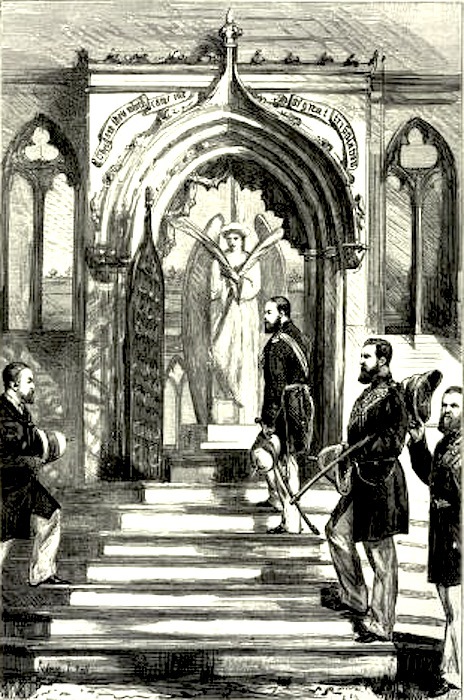
The Prince of Wales visits the Cawnpore Memorial in 1876. Source: Russell, facing p. 401.
The angel can, of course, have different meanings for different people. When the Prince of Wales was brought to the spot in 1876, one member of his entourage was quite overwhelmed. It was almost a spiritual experience: "I cannot describe the effect of the bright moon's rays on the white marble work — or how the whole memorial stood out in its lonely grandeur on that delightful night" (Gay 237-38). But another one looked at it more objectively: "No two persons agree as to the expression of Marochetti's Angel which stands over the Well. Is it pain? — pity? — resignation ? — vengeance ? — or triumph?" (qtd. in Beresford 168). As years go” by, a monument can gather new meanings, too. As Stephen Heathorn has pointed out, a "memorial monument such as that at Cawnpore cannot alone convey transparent expressions of intended (or even accreted) social and political meaning." He continues, “the object does not, nor ever did, speak for itself. To determine significance we must examine the intermediaries between the social and political worlds and the monumental representation; how observers have perceived and interpreted the meaning of the object and transmitted that perception to others” (n.p.). Unlike the angels at each corner of the Scutari obelisk, this one stands in front of a cross, signalling the monument's essentially Christian meaning. But it was, after all, erected” by those who had appropriated power in India, and wealth – who had made the sub-continent part of their empire, and its peoples a subject race.
As part of a larger ensemble, the sculpture's context cannot be overlooked. The Gothic battlements of the screen attracted some adverse attention even at the time: Henry George Keene, who wrote a guidebook to the area, dismissed it as "Carpenter's gothic," finding its crocketted battlements "frivolous" and its finials "purposeless" (44). His only praise was for Yule's fine entrance, and even that seemed pointless when the structure had no roof. Perhaps there was a point though: raised high on the flat plain, the screen suggested not only a church with mullioned Gothic windows, but a keep – superiority in secular as well as sacred matters. Yule, while in Edinburgh on furlough in the early 1850s, had in fact given lectures on fortification at the Scottish Naval and Military Academy (see MacLagan 110). There is another dimension too. While Canning himself paid for the sculpture, the large park surrounding it was paid for” by a levy on the citizens of Cawnpore, as a sort of punishment (see Davies 138; Ward 550). All this supports Henderson's argument when she elides the angel's association with victory over death with a more earthly victory, the putting down of the rebels, and points out that "[t]he iron gate to the Memorial Well monument reputedly was made of cannons captured from the enemy" (18). The fact that the only Indians allowed into the surrounding park were the gardeners and water carriers is also telling. Questions about this exclusion were later raised in the House of Commons, so it must have been a significant issue, but, as Lord Hamilton said in January 1902, it did not seem "advisable to give any instructions in the matter to the Government of India" ("Cawnpore Memorial Well").
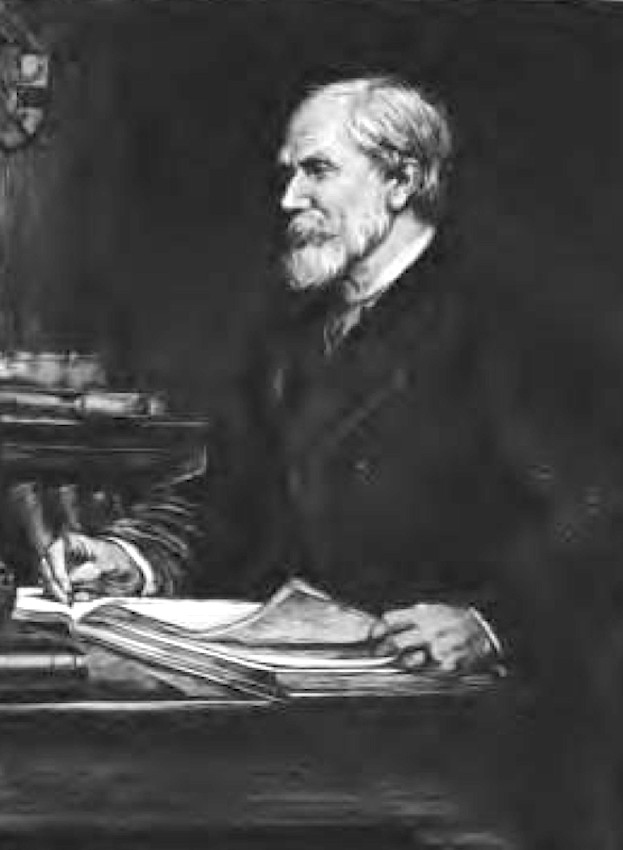
Colonel Henry Yule. Source: frontispiece, Yule.
There are grounds, then, for seeing the monument as a standing rebuke to the perpetrators of the massacre, as well as a memorial. This would not be surprising. Yule, the son of a Major in the Bengal Army, had been in India since 1840, and had lived through all the intense pressures of the uprising; Thornhill's brother, a local magistrate, had been held at the Bibigarh and shot, and his sister-in-law consigned to the well (see Yule xxxiii, xlviii; Ward 411). Certainly, there is no denying that the people of Cawnpore resented the whole thing. On the very eve of independence, "Kanpur city residents massed to enter the garden and take down the memorial" (Henderson 19). Within a couple of years it had been removed, and it was later replaced” by a statue of Tantia Topi, the rebel leader serving as Nana Sahib's lieutenant, acknowledged even” by the British to be the braver and more competent of the two (see Featherstone 149). Whether representing Pity and Resurrection, or Victory and Empire, or perhaps all of these, it has been installed in the churchyard of nearby All Souls Memorial Church. The church, completed in 1875” by one of the best British architects then working in India, Walter Granville, already contained memorials to the British men who died at Cawnpore in 1857. Like the Crimean war memorial in the English Cemetery at Scutari, it has been well looked after. Recent photographs show the angel surrounded” by flowers. In both places, Marochetti's gracefully brooding angels transcend the sad events which they commemorate, provoking a variety of reflections on human behaviour and destiny.
Related Material
- Louisa Beresford's Sketch for the Statue of the Cawnpore Angel
- A Letter from Cawnpore
- The Massacre [of the men] at Cawnpore (painting)
- Sati Chauri Ghat, or Massacre Ghat
- Massacre in the Boats off Cawnpore (painting)
- Cawnpore Memorial (Woolner's unexecuted design)
- Representations of the Indian Mutiny in Victorian Higher Journalism
- British Funerary Sculpture
- All Souls Memorial Church, Cawnpore
- The Crimean war Memorial
Bibliography
Adams, William Henry Davenport. India: Pictorial and Descriptive. London: Nelson, 1888. Internet Archive. Contributed by the University of California Libraries. Web. 18 March 2015.
Beresford, Charles. Memoirs of Charles William de la Poer Beresford Beresford. Boston: Little, Brown, 1914. Internet Archive. Contributed by Harvard University. Web. 18 March 2015.
Butler, Patricia. "A Victorian Watercolourist." Irish Arts Review. 157-62. Digitised in collaboration with JSTOR and available online here. (This gives some impressive examples of her artwork.) Web. 18 March 2018.
"The Cawnpore Memorial." The Builder XXI (1863): 267. Google Books. Free Ebook. Web. 18 March 2015.
"Cawnpore Memorial Well." House of Commons Debate, 27 January 1902. Hansard. Vol. 101: 959-60. Web. 18 March 2015.
Dalrymple, William. The Last Mughal: The Fall of a Dynasty, Delhi, 1857. Delhi: Penguin, 2007.
David, Saul. The Indian Mutiny, 1857. London: Viking, 2002.
Davies, Philip. Splendours of the Raj: British Architecture in India 1660-1947. London: Penguin, 1987.
"Details of Sculptor: Marochetti, Carlo, Baron RA." A Biographical Dictionary of Sculptors in Britain, 1660-1851 (Henry Moore Institute). Web. 18 March 2018.
Featherstone, Donald. Victorian Colonial Warfare: India. London: Cassell, 1992.
Forrest, G. W. A History of the Indian Mutiny. Vol. I. Edinburgh and London: Blackwood, 1904. Internet Archive. Contributed by the Robarts Library, University of Toronto. Web. 18 March 2015.
Gay, J. Drew. The Prince of Wales in India, or From Pall Mall to the Punjaub. New York: R. Worthington, 1877. Internet Archive. Web. 18 March 2015.
Hare, Augustus J. C. The Story of Two Noble Lives, Being Memorials of Charlotte, Countess Canning, and Louisa, Marchioness of Waterford. Vol. I. London: George Allen, 1893. Internet Archive. Contributed by Harvard University. Web. 18 March 2015.
_____. The Story of Two Noble Lives, Being Memorials of Charlotte, Countess Canning, and Louisa, Marchioness of Waterford. Vol. II. London: George Allen, 1893. Internet Archive. Contributed by Harvard University. Web. 18 March 2015.
_____. The Story of Two Noble Lives, Being Memorials of Charlotte, Countess Canning, and Louisa, Marchioness of Waterford. Vol. III. London: George Allen, 1893. Internet Archive. Contributed by Harvard University. Web. 18 March 2015.
Heathorn, Stephen J. "Angel of Empire: The Cawnpore Memorial Well as a British Site of Imperial Remembrance." Journal of Colonialism and Colonial History. 8/3 (Winter 2007). Access via Project Muse (no page numbers). Web. 18 March 2015.
Henderson, Carol. Spatial Memorializing of Atrocity in 1857: Memories, Traces, and Silences in Ethnography." Draft of a paper prepared for the Conference "Mutiny at the Margins: New Perspectives on the Indian Uprising of 1857," Edinburgh University, 23rd-26th July 2007.
Keene, Henry George. A Handbook for Visitors to Lucknow. Delhi: Asian Educational Services, 2000.
Llewellyn-Jones, Rosie. The Great Uprising in India, 1857-58: Untold Stories, Indian and British. Woodbridge, Suffolk: Boydell and Brewer, 2007.
MacLagan, Robert. "Obituary of Colonel Sir Henry Yule, KCSI, CB, LL.D., R.E." Proceedings of the Royal Geographical Society and Monthly Record of Geography. New Monthly series, 12/2 (Feb. 1890): 108-113. Accessed via JSTOR. Web. 18 March 2015.
Morris, Jan, with Simon Winchester. Stones of Empire: The Buildings of the Raj. Oxford: Oxford University Press, 1983.
Mukherjee, Rudrangshu, and Pramod Kapoor. Dateline 1857: Revolt against the Raj. New Delhi: Lustre Press, Roli Books, 2008.
"Peace Fete At The Crystal Palace." The Times. 10 May 1856: 9. Times Digital Archive. Web. 18 March 2015.
Reynolds, K. D. "Canning [née Stuart], Charlotte Elizabeth, Countess Canning (1817–1861), courtier and vicereine of India." Oxford Dictionary of National Biography. Online ed. Web. 18 March 2015.
Ritchie, J. Ewing. The Life and Times of William Ewart Gladstone. 5 vols. London: William Mackenzie, n.d.From the Collection of Professor Ernest Chew, National University of Singapore.
Russell, William Howard, Sir. The Prince of Wales' Tour: A Diary in India; with some account of the visits of His Royal Highness to the courts of Greece, Egypt, Spain, and Portugal. 2nd ed. London: Sampson Low, Marston, Searle and Rivington, 1877. Internet Archive. Web. 18 March 2015.
"The Scutari Monument." Hansard. 8 July 1856. Vol. 143: 493-5. Web. 18 March 2015.
S. H. K. "Monuments of the Indian Mutiny." The Foreign Missionary of the Presbyterian Church. Vol. XXX (1871-72). Google Books. Free Ebook. Web. 18 March 2015.
Sugirtharajah, R. S. The Bible and Empire: Postcolonial Explorations. Cambridge: Cambridge University Press, 2005.
Tickell, Alex. "Cawnpore, Kipling and Charivari: 1857 and the Politics of Commemoration." Literature and History. 18(2): 1–19. Open Research Online (The Open University). Web. 18 March 2015.
Ward, Andrew. Our Bones are Scattered: Cawnpore Massacres and the Indian Mutiny of 1857. London: John Murray, 1996.
Yule, Amy Frances. "Memoir of Sir Henry Yule." In Ser Marco Polo, The Venetian. Ed. and trans. Henry Yule. Vol. I. New York: Scribner's, 1903. xxvii-lxxiv. Internet Archive. Contributed by Harvard University. Web. 18 March 2015.
Last modified 18 March 2015